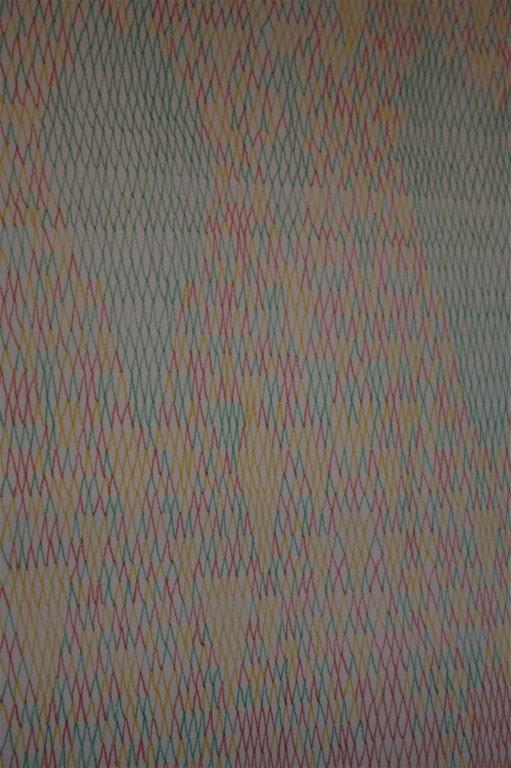Emergence of Order – Japanese artist Goro Murayama at the Daiwa Foundation
By James Brewer
My art deals with thinking about human creativity in the computer age, says Tokyo-based Goro Murayama.
He is a practitioner of “systems art,” a manifestation of the integration into art of new means of communication – just as canals and waterways influenced artistic expression when they first motivated advances in society, or as 20th century free-market globalisation dictated new trade patterns.
He has had a month-long (until April 25, 2018) exhibition courtesy of the Daiwa Foundation at Japan House, in Cornwall Terrace opposite Regent’s Park, highlighting the somewhat complex background to self-organising processes and patterns through painting and drawings.
His is a method facing up to the data-driven, dark-power age. Because the world is to a large degree in thrall to computers and artificial intelligence, the concept of order is important for human beings to reconsider their activity as acts and choices are repeated.
Whatever the degree of self-organisation, a master craftsman or woman is still needed at the helm, and this is where this skilled practitioner comes in. The outcomes are ultimately moored in the achievements of humanity, even when mediated by new revelations of computer power.
In an artist’s talk at the Anglo-Japanese foundation, an institution which showed yet again that it is unafraid to promote non-mainstream art manifestations, Goro displayed his fascination and intense knowledge of decades of radical and fundamental theories of life systems. He focuses on autopoiesis (self-creation), and on the life-like patterns he has produced in a new system of hand-drawn, computer-simulated cellular automata (discrete models from science), which appear like the roads of a maze woven together.
In his first exhibition in the UK, the materiality of huge woven hemp cords – three of the seven pieces on the walls – appeared to belie their origin in self-organising processes based on what to the average observer would be arcane analytics.
He built up his tapestries by weaving a canvas, painting the base, and adding drawings shaped by autonomous decisions stemming from the properties of the cord, primer and paint.
As he has pursued this path in recent years, he says that further developments emerged from the variables latent in the production, making works that are increasingly complex in structure. The fabric is a tree structure which harks back to systems furnished by nature, such as plants. That defines the order in which the branches are woven. It changes as if he is a part of the simulator he organises. The arbitrary and random expansion of the work is comparable to the seemingly uncoordinated growth of tree branches: the speed of growth of each branch is a variable of the system.
Goro thus has an emotional investment in what might otherwise be a dispassionate process. He considers painting as “a mandala [a circular figure representing the universe in Hindu and Buddhist symbolism] of emergences that appears when the mind, affected by forms and shapes, reiterates and amasses actions.”
His selection of works for London was along the lines of his solo exhibition The Re-enchantment of Painting System at the Shiseido Gallery in Tokyo in 2010.
He argues that the concept of systems suggests processes which are constantly regulated, or structured operations considered to be detached from art, the act of human creation and expression. Think of the ways in which the word ‘system’ is used: computer system, cultural system, economic system, subsystem, ecosystem. On the other hand, systems art is “associated with the dematerialisation of artworks, the tendency towards taking information and process as a medium, and the rise of cybernetic art in contemporary art.”
In his talk, Goro illustrated how systems theory emerged in the mid-20th century alongside conceptual art and theories such as cybernetics and information theory.
His brief history of the highlights of systems art, starting with the 1966 exhibition Systemic Painting, organised at the Guggenheim Museum, New York, by the art critic Lawrence Alloway, who coined the phrase systemic painting, encompassing a wide range of artworks with a simple, methodical, organisation exploring repetition and pattern.
Others who were influential at that stage included the Japanese art critic Toshiaki Minemura, and the Dutch photographer Jan Dibbets who sought to create a dialogue between nature and geometrical design in a series of photos where he systematically increased the shutter speed. Following that, Mario Merz set up installations accented with words or neon numbers that counted off the Fibonacci progression, the mathematical formula for growth patterns found in leaves, snail shells, pine cones and reptile skins.
A second wave of what might be called systems art included Sol LeWitt, noted among other works for Wall Drawing #122, first installed in 1972 at the Massachusetts Institute of Technology, and containing “all combinations of two lines crossing, placed at random, using arcs from corners and sides, straight, not straight and broken lines,” resulting in 150 unique pairings on the gallery walls. Hanne Darboven followed in 1975 with her Card Index: Filing Cabinet, Part 21975. All these experiments were linked to conceptual art, and Goro said that this phase “I believe is slightly outdated.”
Goro Murayama explained what is known as autopoiesis, or self-sustaining systems, developed by the Chilean biologists Humberto Maturana and Francisco Varela in 1972. Derived from the Greek words for self and creation, autopoiesis is a system capable of reproducing and maintaining itself, having been originally the definition of the self-maintaining chemistry of living cells.
Today systems theory has been applied to cognition, law, sociology, medicine and more. Within sociology, the late Niklas Luhmann brought it to the fore.
In this interdisciplinary study, a collection of interrelated and interdependent elements that is either natural or man-made can be more than the sum of its parts. Goro showed diagrams of what is known as cellular automata, consisting of a grid of any dimension of cells. A key researcher, mainly with computer simulations, has been Stephen Wolfram at the School of Natural Sciences of the Institute for Advanced Study at Princeton. Wolfram’s book A New Kind of Science postulated that in even extremely simple computational rules or programs can yield behaviour of great complexity, and produced a classification scheme for the complexity of cell behaviour. Wolfram’s cellular automata has a row of cells, each black or white, which show the evolution of patterns into structures: the whole has properties that the parts lack.
Elsewhere, since the late 1990s, Sarah Sze developed a signature visual language that challenged the static nature of sculpture, with dynamic constellations of materials that are charged with flux, transformation and fragility. It is said that her work “simultaneously models and navigates the ceaseless proliferation of information in contemporary life.”
Speaking at the Daiwa Foundation, Goro Murayama was in conversation on April 18 with a leading authority in the speciality, Dr Francis Halsall, for a presentation entitled System as Medium and System as Motif.
Dr Halsall, who is lecturer in visual culture at National College of Art and Design, Dublin, is author of the book Systems of Art, on the implications of systems theory for artistic practice. He said that we can see systems as a metaphor for organisation, the way in which humans think about the world; or in biological systems relating to underlying structure.
He said that a section of artists working in the 1960s onwards, after modernism and using computers, telecommunications, cybernetics and so on, were using systems as a metaphor, on the other hand there was a deeper use of the system than technology, in the desire to create systems as another way of thinking about modernity more generally, a desire to find organisation. Putting it into broader context, he said that we find different metaphors for the human in history, for instance in Adam Smith talking about the economy, or when canals and water were predominant in communication.
Relating systems to painting, Goro followed a set of rules to create the weaving, and relationship between the paint surface and the pattern. Creativity and technology integrate, in a manner indefinite and undefined.
On the question of how Goro Murayama’s work fits in relation to the history of systems art and current tendencies in artistic practice, his work looked quite biological compared with the early systems work which was much more machine-like. Goro was using the mathematical process to show something that is beginning to look more like the natural world.
“It is not about computers, it is about systems,” said the Dublin academic. Identification of systems was about finding underlying patterns, and “you can see how the human is implicated in this.”
Born in Tokyo, Goro Murayama took an MA in fine art at Chelsea College of Arts in 2011 and gained a PhD in oil painting from Tokyo University of the Arts in 2015. He has had several solo exhibitions since 2010 in Tokyo, and one in Vienna.
Dr Halsall is working on projects under the theme of Systems Aesthetics, as chronicled on his blog: www.alittletagend.blogspot.com
Photographs with this article marked with an asterisk * are kindly contributed by Suzanne Hennie Tennes.
Emergence of Order by Goro Muroyama is at the Daiwa Foundation Japan House 13/14 Cornwall Terrace, London NW1 until April 25. 21 Monday to Friday9.30am–5pm.












